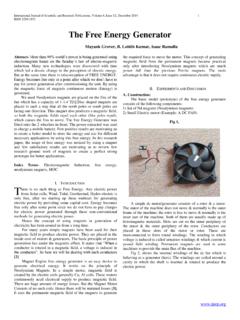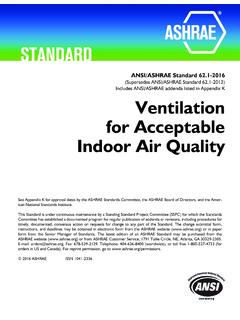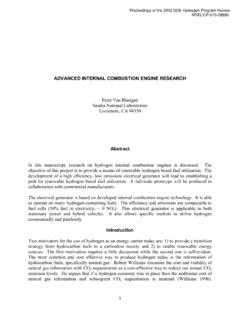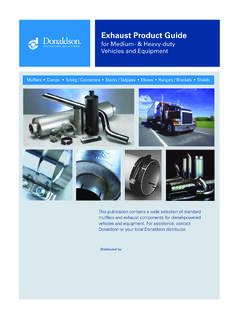Transcription of GCSE Geography Textbook sample - AQA
1 GCSEAQA geographyNew for 2016A genuinely student-friendly approach, with rigorous coverage of the specHow the course supports the specificationHow is the course structured?EvaluationThe Evaluation Pack for this course is free for 90 days and contains a copy of the Student Book and information about the supporting Kerboodle resources, including sample Teacher Handbook material. To order yours, please return the tear-off form at the back of this 019 836664 5 Summer 2016 Student Book contents AQA gcse Geography draft specification (accredited February 2016)Unit 1: Living with the physical : Living with the physical environment Section A: The challenge of natural Section A1 What are natural hazards?
2 Natural hazards2 Tectonic Tectonic hazards3 Weather Weather hazards4 Climate Climate changeSection B: The living Section B5 Ecosystems 6 Tropical Tropical rainforests 7 Hot Hot deserts 8 Cold Cold environments Section C: Physical landscapes in the Section C9 UK UK physical landscapes 10 Coastal Coastal landscapes in the UK11 River River landscapes in the UK12 Glacial Glacial landscapes in the UKUnit 2: Challenges in the human Challenges in the human environmentSection A: Urban issues and Section A: Urban issues and challenges13 A rapidly urbanising worldSection includes the growth of the world's urban population, a case study of a major city in an LIC or NEE, urban change in UK cities, and urban sustainability14 Urban change in the UK15 Urban sustainabilitySection B: The changing economic Section B: The changing economic world16 The development gapSection includes global variations in economic development, strategies for reducing the development gap, a case study of a LIC or NEE, and changes in the UK economy17 Nigeria: a newly emerging economy18 The changing UK economySection C: The challenge of resource Section C.
3 The challenge of resource management19 Resources in the UK Resource management20 Food Food21 Water Water22 Energy EnergyUnit 3: Geographical Geographical applications23 Issue Section A: Issue evaluation24 Section B: Fieldwork25 Geographical skillsGlossaryIndexOS map keyStudent Book978 019 836661 4 Summer 2016 The Student Book for this course has been approved by page 4 for more details23 This new course for the 2016 AQA gcse Geography specification is from a team led by experienced AQA author Simon Ross. The clear approach engages students and motivates them to progress, while the specification coverage helps them to build the skills they need and prepare effectively for their final Coverage of the new specification includes all the options, plus support for skills and fieldwork integrated throughoutl Clear page design and accessible language which will appeal to your studentsl Kerboodle provides schemes of work, homework materials, a comprehensive assessment package, a digital Student Book.
4 And a digital Teacher HandbookTake a genuinely student-friendly approach to the new specificationMeet the teamSeries editor Simon Ross is the former Head of Geography and Assistant Head at Queen's College, Taunton. He s a GA consultant and a teacher trainer and has worked on a wide range of Geography resources, including the nelson Thornes AQA-approved course for the AQA gcse Geography A specification for 2009, for which he was also the series Nicholas Rowles is an experienced author and has examining experience. The fieldwork chapter is by experienced authors David Holmes and Bob : Resources and Assessment978 019 836662 1 Summer 2016 See pages 6-10 for more detailsIncludes your Kerboodle Teacher Handbook and teacher access to the Kerboodle Student BookKerboodle Student Book: student access978 019 836663 8 Summer 2016 The Kerboodle Student Book for this course has been approved by page 10 for more detailsStudent BookThe Student Book combines a student-friendly approach with excellent coverage of the specification.
5 It has been approved by this spread you will find out about responses to earthquakes in Chile and Nepal On this spread you will find out about flooding on the Somerset Levels in 2014 The Somerset Levels Floods, 2014 (1)Where are the Somerset Levels?Somerset is a county in south-west England. The Somerset Levels and the Somerset Moors form an extensive area of low-lying farmland and wetlands bordered by the Bristol Channel and Quantock Hills to the west and the Mendip Hills to the north (map A). The area is drained by several rivers, most notably the Tone and the Parrett, which flow to the Severn Estuary via Bridgwater. Flooding has occurred naturally here for centuries.
6 As the area has been developed for farming and settlement, many people are now at risk from extreme flood caused the floods in 2014?There were several factors that led to extensive flooding of the Somerset Levels. It was the wettest January since records began in 1910. A succession of depressions (areas of low pressure) driven across the Atlantic Ocean brought a period of wet weather lasting several weeks. About 350 mm of rain fell in January and February, about 100 mm above average. High tides and storm surges swept water up the rivers from the Bristol Channel. This prevented fresh water reaching the sea and it spilled over the river banks. Rivers had not been dredged for at least 20 years, and had become clogged with sediment.
7 What were the impacts of the flood?Between December 2013 and February 2014, the Somerset Levels hit the national headlines as the area suffered extensive flooding. It was the most severe flooding ever known in the Over 600 houses flooded 16 farms evacuated Residents evacuated to temporary accommodation for several months Villages such as Moorland and Muchelney cut off. This affected people s daily lives, attending school, shopping, etc. Many people had power supplies cut off Somerset County Council estimated the cost of flood damage to be more than 10 million O ve r 14 000 ha of agricultural land under water for 3 4 weeks Over 1000 livestock evacuated Local roads cut off by floods Bristol to Taunton railway line closed at Bridgwater Floodwaters were heavily contaminated with sewage and other pollutants including oil and chemicals A huge amount of debris had to be cleared Stagnant water that had collected for months had to be reoxygenated before being pumped back into the riversWellsCheddarGlastonburyBurnham-on- SeaBridgwaterTa u n to nYe ov i lRiver ToneRiver
8 BrueRiver AxeRiver ParrettQuantocksMendipsPolden HillsN0100kmAThe Somerset LevelsBRescuing a resident from MoorlandCThe impacts of the Somerset Levels 3406/04/2016 10:3135 Weather hazardsThe Somerset Levels Floods, 2014 (1)Managing the floodsEHow dredging worksACTIVITIES1 Why do you think the Somerset Levels are prone to flooding (map A)?2 What were the factors contributing to the floods in 2014?3 a Describe the extent of the flooding (photo D). b Several roads were flooded. What impact did this have on local people? c Suggest the impact of the flooding on farmers in the Make a copy of diagram E. Add labels to describe how dredging can help reduce the flood risk.
9 Stretch yourselfImagine you are a local councillor in Somerset. Analyse research plans to construct a tidal barrage at Bridgwater (they can be found on the internet).What would this scheme involve and how would it reduce the risk of flooding?Practice questionUsing table C, evaluate the main impacts of the flooding of the Somerset Levels. (6 marks)Immediate responsesAs the floodwaters spread out over the Somerset Levels, homeowners coped as best they could. Villagers cut off by the floods used boats to go shopping or attend school. Local community groups and volunteers gave invaluable village of Burrowbridge D almost cut off by the floodsLonger-term responsesA 20 million Flood Action Plan has been launched by Somerset County Council who will work together with agencies such as the Environment Agency to reduce the risk of future flooding.
10 In March 2014, 8 km of the Rivers Tone and Parratt were dredged to increase the capacity of the river channel (diagram E). Road levels have been raised in places to maintain communications and enable businesses to continue during future flood events. Vulnerable communities will have flood defences. River banks are being raised and strengthened and more pumping stations will be built. In the longer term by 2024 consideration will be given to a tidal barrage at Bridgwater. 1 Silt is deposited on river bed2 Heavy rain causes river to ood3 Diggers or pumps remove siltto build up river banks and increase 3506/04/2016 10 this spread you will learn how Rio is responding to its environmental challengesImproving Rio s environmentWhat are Rio s environmental challenges?


















